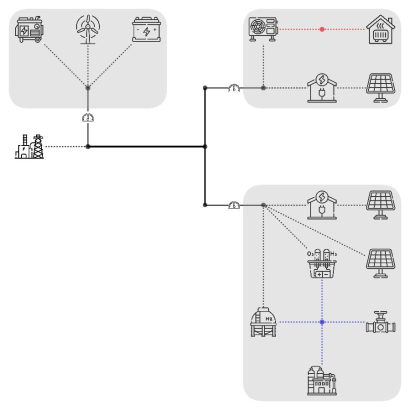Doing the Math – Design of multi-commodity energy networks #SWI2024
Introduction
Navigating the evolving energy landscape necessitates the imperative planning and design of multi-commodity energy networks, driven by various crucial considerations. The motivation for embracing multi-energy systems lies in unlocking efficiency benefits through coordinated efforts, with non-electric energy carriers like hydrogen offering superior long-term storage options and playing a vital role in decarbonization efforts. Despite the pivotal electrification of source energy, demand, particularly in sectors like the chemical industry and aviation fuels, remains partially non-electric. The shift towards decentralized energy systems is prompted by the advantages of distributed generation for renewables and the need for robustness against net congestion, mitigating vulnerabilities associated with single points of failure. Furthermore, the significance of storage in renewable energy cannot be overstated, as weather-based generation leads to demand-independent production, making both short-term and long-term storage solutions imperative for maintaining a reliable and resilient energy network.
The transition to decentralized energy systems necessitates intelligent management and optimization of bidirectional energy flows, ensuring grid stability amidst varying demand and supply conditions. The interdependency of energy commodities adds another layer of complexity, requiring meticulous modeling and optimization efforts. Long-term infrastructure planning, encompassing generation, storage, and distribution facilities, is crucial for accommodating multiple commodities and must consider factors such as cost, environmental impact, and spatial constraints. Additionally, the uncertainties inherent in energy systems, related to commodity prices, weather conditions, and geopolitical factors, underscore the importance of robust risk management strategies. Achieving optimal resource allocation is fundamental for the cost-effectiveness and sustainability of multi-commodity energy networks, demanding careful analysis that balances economic, environmental, and social objectives.
Problem description
To systematically address the intricate challenges outlined above, the analysis of multi-commodity energy networks will be undertaken in distinct phases. The initial phase concentrates on designing multi-commodity energy hubs (see the figure below for an example), usually business parks, with a primary emphasis on achieving grid independence. These energy hubs serve as central points where various energy carriers, including heat, electricity, and hydrogen, are integrated. The overarching goal is to mitigate companies’ dependence on the grid, especially in regions with net congestion that might impede energy contract expansions. To overcome these challenges, companies must collaborate to share combined capacity or individually invest in renewable energy sources such as solar and wind. The incorporation of energy storage solutions like batteries, and conversion technologies like heat pumps and electrolysers for generating hydrogen, plays a crucial role in creating a viable and resilient local energy system. While emergency gas-powered generators can be employed to fill in gaps, the focus is on minimizing their usage not only due to cost considerations but also to reduce the associated carbon footprint. This strategic approach aims to foster sustainable, locally resilient, and grid-independent multi-commodity energy networks.
Moving into the next phase of analysis, the focus expands to encompass the transformative shift from traditional energy carriers, such as gas and other fossil fuels, to electric or sustainable alternatives like hydrogen or ammonia. This phase requires a comprehensive modeling approach that not only considers energy flows between companies within the energy hub but also delves into the internal energy dynamics within individual company buildings and production processes. For instance, replacing a gas-fired oven with a steam-based oven or incorporating industrial heat pumps necessitates a thorough understanding of the energy transition at the micro-level. The transition from established technologies to sustainable alternatives involves a considerable investment of both time and financial resources. Therefore, this phase aims to extend the analytical scope to include the intricate dynamics of indoor energy flows and the corresponding required investments. The overarching objective is to formulate a design that is not only the most sustainable and cost-effective at the macro-level but also accounts for the timing of technology transitions within individual buildings. This holistic approach ensures that the evolution towards sustainability is not only efficient on a large scale but also tailored to the specific needs and constraints of each company within the multi-commodity energy hub.
In the final phase of analysis, attention shifts towards examining the synergies and enhancements achievable by interconnecting multiple energy hubs, for example, in large industrial areas like the Rotterdam or Amsterdam harbor area or Chemelot in Geleen. This involves exploring the potential benefits of shared infrastructures such as cables for electricity transmission from renewable sources like wind turbines and pipes for the distribution of heat and renewable gases or fluids like hydrogen and ammonia. The primary focus remains on optimizing the overall system design to minimize investment costs, reduce the carbon footprint, and enhance grid independence. By strategically connecting these hubs, the aim is to create an integrated network that leverages each hub’s strengths to benefit the whole system. This phase involves a sophisticated evaluation of the trade-offs between investments, environmental impact, and grid resilience, seeking to establish a design that not only meets the energy demands of individual hubs but also contributes to the broader sustainability and efficiency objectives of the interconnected multi-commodity energy network. The collaborative and interconnected nature of this final phase underscores the importance of holistic planning and design in fostering a resilient, sustainable, and grid-independent energy ecosystem.
Expected Results
Creating one comprehensive mathematical model to address the multi-faceted challenges outlined in the problem description will pose challenges due to the complexity and diversity of the considerations involved in each phase. However, a holistic model that encompasses the entire multi-commodity energy network analysis might be feasible with careful design and abstraction. The model would need
to be dynamic and flexible, capable of adapting to the evolving nature of energy systems and accommodating diverse factors such as energy flows, investments, carbon footprints, renewable generation, assets dimensioning, and grid independence. Despite the feasibility, the challenge lies in balancing the complexity of the model with its practical utility. The model may need to strike a balance between being detailed enough to capture the nuances of each phase and being manageable enough for efficient computation and decision-making.
For the solution to be useful for investors and policymakers, it should provide actionable insights and information that can guide decision-making in the planning, development, and optimization of multi-commodity energy networks. Below, we present outcomes that would make the model valuable for these stakeholders in decreasing order of importance:
- Optimal Investment Strategies. The solution should offer insights into optimal investment strategies for building and upgrading energy hubs, transitioning technologies, and interconnecting hubs. It should quantify the costs and benefits associated with different investment options, helping investors allocate resources efficiently. It should help with understanding the optimal timing and phasing of investments and provide insights into when technology transitions should occur and how investments can be staggered for maximum efficiency.
- Carbon Footprint Reduction. The solution should quantify the environmental impact of different decisions, providing data on the reduction of the carbon footprint associated with technology transitions, renewable energy adoption, and overall system optimization. This information is crucial for policymakers focused on sustainable development.
- Policy Recommendations. The solution should generate insights that can inform policy recommendations. This includes identifying regulatory frameworks and incentives that can encourage sustainable practices, technology transitions, and collaboration among companies within the energy hubs.
- Adaptability and Scalability. The solution should be adaptable to different contexts and scalable for various sizes of energy hubs and networks. This allows decision-makers to apply the insights to diverse projects and regions.
About Doing The Math
Doing the Math (DTM), founded in 2019, specializes in helping organizations achieve their climate goals and garner support from employees, partners, and stakeholders. DTM-ers have many years of experience in applying optimization techniques to business problems. By leveraging this expertise, the company assists in making informed decisions and driving significant transformations. In the context of global efforts to combat climate change, particularly guided by the Paris
Agreement’s goals, Doing the Math aids businesses and institutions in operationalizing strategies through clear insights, communication, and decision support. The company focuses on energy markets, supporting the energy transition, and supply chains. This includes reducing carbon footprint and improving supply chain resilience. DTM aims to enhance organizational performance in these specific areas, emphasizing the urgency for those committed to taking action on climate goals.


